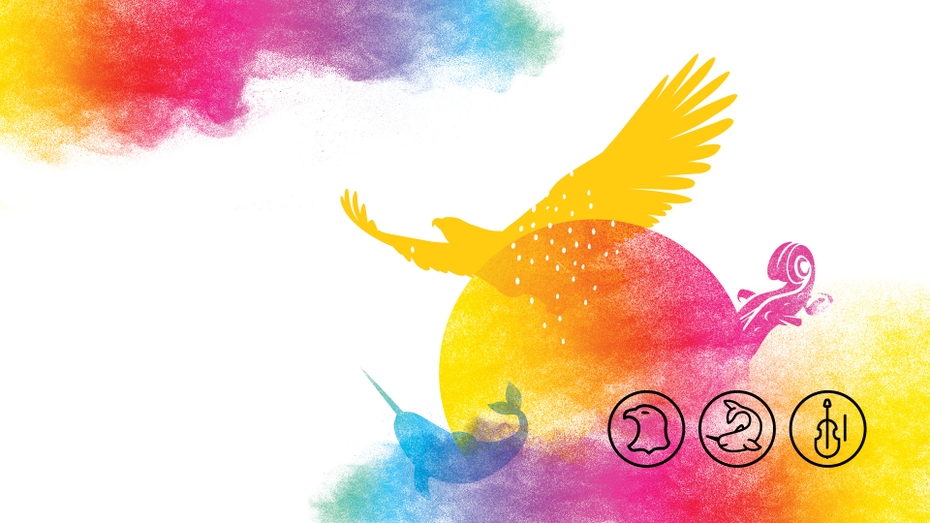This issue of Our College News is dedicated to National Indigenous History Month, as we aim to learn more about the unique heritage, diverse cultures, and outstanding contributions of First Nations, Inuit, and Métis peoples. This month, we also recognize the Strawberry Moon, Summer Solstice (June 20), and National Indigenous Peoples Day (June 21).
Thank you to Indigenous Student Advisors Jessie Pengelly and Shirley Chaisson for providing thought-provoking questions, and those that took the time to share their insight and perspective on Indigenous Ways of Knowing and Being and how we can each take reconciliACTION, meaningful steps to move reconciliation forward, not just during Indigenous History Month, but throughout the year:
- Holly Karennehá:wí Brant, Indigenous Counselor with Student Wellness and Accessibility
- Christina Chrysler, Professor/Program Coordinator, Visual & Creative Arts - Fine Arts, Program Coordinator, 1000 Islands Summer School of the Arts
- Michael Cooke, VP Student Affairs (interim)
- Sara Craig, Professor, Practical Nursing
- Derek Davies, Professor and Program Coordinator, Community and Justice Services
- Sarah Durant, Student Success Facilitator
- Jennifer Haley, Associate Dean, Cornwall Campus
- Jordan Ann Kevan de Haan, Coordinator/Professor, Environmental Technician
- Katie Jock Lamarche, Indigenous Recruitment and Community Engagement Officer
- Jody Souka-Marleau, Coordinator/Professor, Social Service Worker, Cornwall
Land Acknowledgement

St. Lawrence College is situated on the traditional lands of the Anishinaabe and Haudenosaunee peoples. May we always be grateful to live and learn on these lands.
What does Indigenous History Month mean to you?
Holly: It means reflecting on what our ancestors had been through to ensure their children and grandchildren and seven generations from now can live a good life. History is told through the lens of the beholder and to be vigilant to understand who the author is and what their motivation may be. It means canoeing through the river of life with settlers on the other side and acknowledging we can navigate these waters as long as both sides are respectful, truthful, friendly, and are willing to build a relationship that is reciprocal. We just want to be treated as you would treat your kin, we are more alike than different; however, we do not want to be shaped in your likeness, we want to be Onkwehonwe, who Creator made us to be.
Sara: For me, Indigenous History Month is a time to learn more about the history of Indigenous people, spend time immersed in Indigenous culture, and acknowledge the impact of the Indian Act and the Residential School system on Indigenous communities, families, and culture.
Derek: Like any other month, it is a time to continue to be open to learning more about Indigenous Ways of Knowing and Being. It is also a time to reflect upon the impact that colonization and residential schools had on Indigenous Peoples and continues to have today. It is also an opportunity for me to learn more about what I can do and help others do in taking reconciliACTION. Lastly, it is a time to continue to celebrate Indigenous Peoples and an opportunity for me to share that we all have a part in this.
Katie: It's a start perhaps for some folks in terms of engagement and awareness, and an opportunity to connect on a larger scale for many Indigenous folks! I'm always conflicted because I love to celebrate my culture and experience other Indigenous cultures as much as possible, but I'm also saddened because I wish I could see and do it more often. Indigenous history especially should not be dedicated to just a month.
Jody: An opportunity to promote awareness, dialogue, and share stories that offer hope and resiliency for healing. Mourning the losses of the past helps us to tune into the feelings, thoughts, and behaviours that need repairing or releasing so that the focus shifts to strength, purpose, and making wise choices.
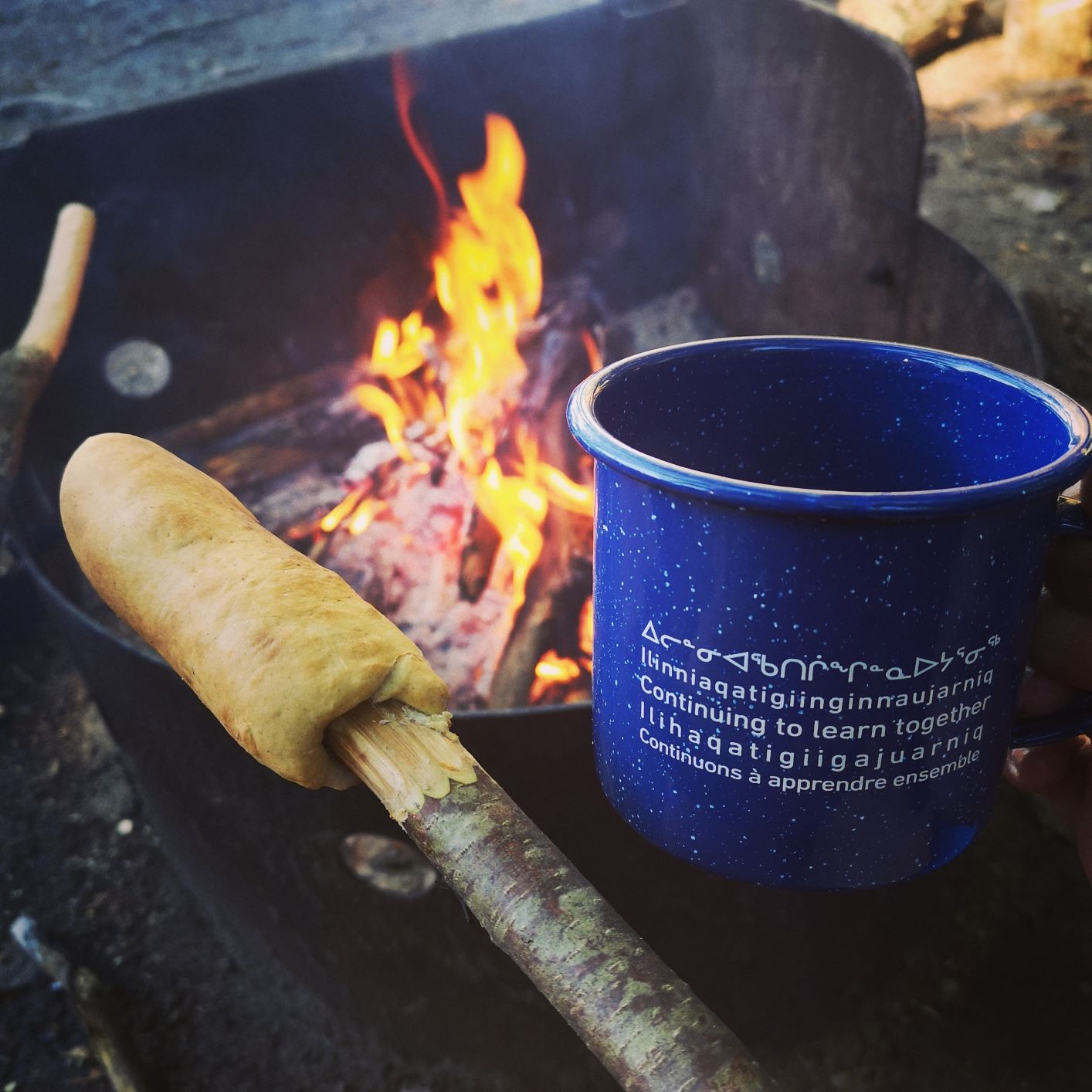
Enjoying bannock by the campfire.
How do the moon teachings impact your journey?
Holly: Our Grandmother Moon teaches us how to be honest and to work in conjunction with our kin because she continues to follow the Creator's original instructions. She is our oldest Grandmother and assists in all female related matters such as guiding the arrival of babies to this side of the sky and influencing the ebb and tide of the waters. She brings light to the night time sky and marks the passage of time, all the while working with our Elder Brother the Sun or our Grandfathers The Thunderers or our other kin. She teaches us responsibility and to love unconditionally and we are grateful for those teachings.
Christina: Great question! While I am not Indigenous, these teachings resonate with me and I often reflect on my understanding of them as a way of being more connected to the natural world around me and to understand and interpret imbalances that can occur when getting too caught up in the busy-ness of life. They ground me and connect me to a greater purpose.
Sara: The Grandmother moon represents the cycles of Turtle Island; tides in the ocean, planting, harvesting, hunting, and renewal of the earth. For women, moontime is a time of reflection, power and renewal during menstruation. The community respects this time of reflection and renewal and lets the woman rest. I wish I could incorporate these teachings into my life!
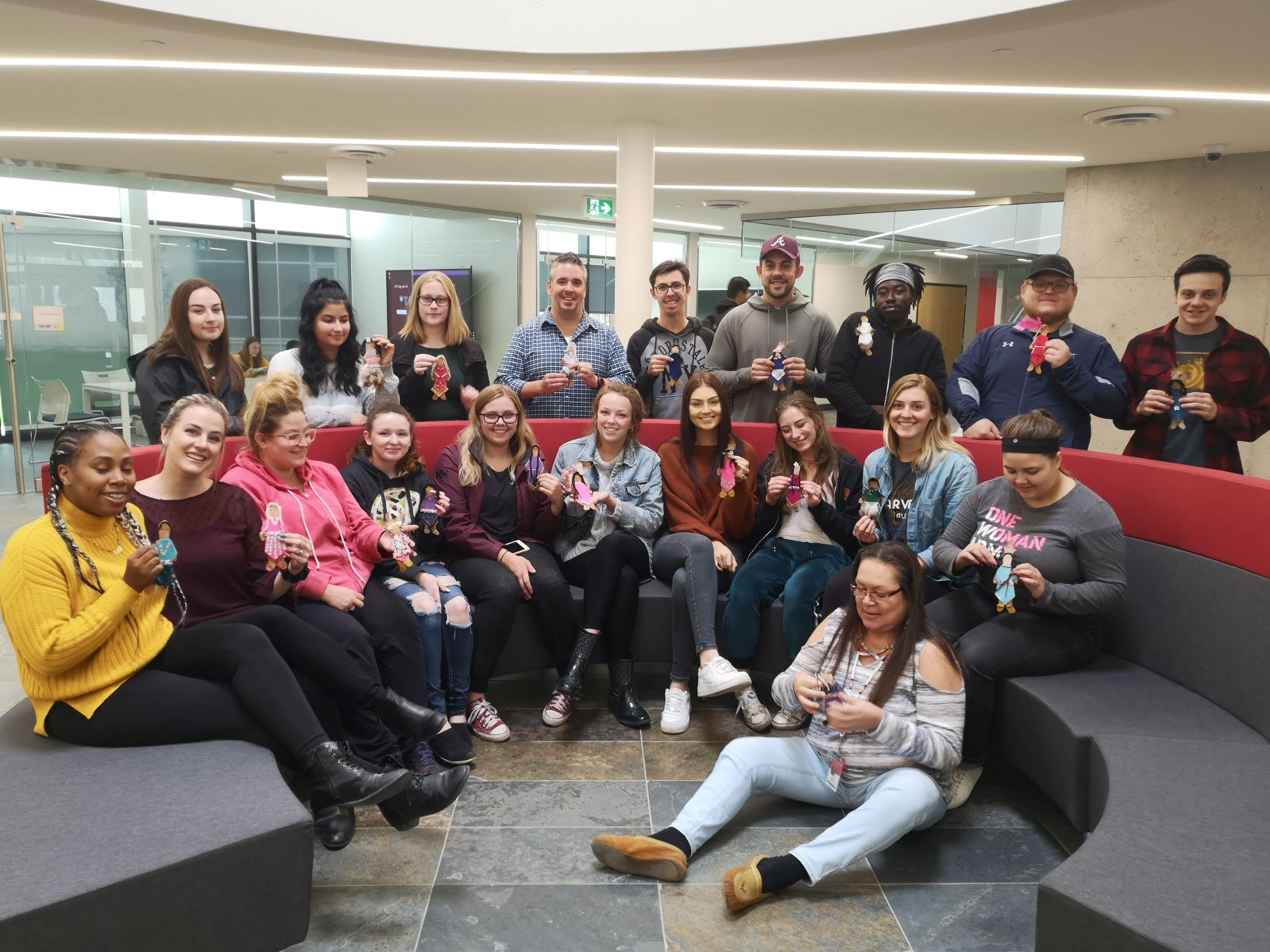
Each year, Indigenous Services and members of the SLC community take part in the Faceless Doll Project to remember the missing and murdered Indigenous Women, Girls, and 2 Spirit and show support to address violence against IWG2S. Faceless Dolls are a visual representation of missing and murdered Indigenous women and girls so they will not be forgotten. Each doll is unique just like the people they represent.
What teachings would you give to someone who wanted to be an ally?
Holly: It is up to each individual person to reflect on themselves on how to become an ally. They must "unsettle" themselves and choose to not be a continuing colonist. Overall, the settler must make a choice.
There is no one key or "best" practice, but a simple framework that must be respected.
- Examine position of privilege.
- Listen, be honest, open and authentic from the beginning.
- Be aware of the histories – try to understand Indigenous history.
- Acknowledge the history of colonialism.
- Do not try to speak for us, we can speak for ourselves.
- Make space for Indigenous voices for an Indigenous perspective.
- Building respect & trust is a process and takes time and commitment.
- Consult do not conclude.
- All must come to the table on an equal basis (all who teach learn, all who learn teach)
- Do not assume "taken for granted assumptions" they are usually embedded colonial structures
- Face and acknowledge the face of anger.
- Changing and confronting the status quo is "unsettling".
- Be flexible, it is going to change, it is going to challenge.
- Mistakes will happen, being vulnerable is difficult work, both sides can face that fight, this is fluid & always changing.
- Use your privilege to uphold an Indigenous cause.
- Most of all, be positive!
Lynn Davis, (ed) (2010). Alliances: re/envisioning indigenous non-indigenous relationships.
1. Learn and be a part of Orange Shirt Day
2. Learn and be a part of Missing and Murdered Indigenous Women and Girls Faceless Doll Project
Indigenous people overall prefer to use the word "wise" practices because "best" implies they know what is best for everyone when that is not the case, wise practices implies they will share what they themselves have found to be helpful in a particular context.
Michael: Be silent. Listen. Offer friendship. Walk slowly and carefully. Ask.
Sarah: I would suggest an ally learn about the history of colonization, treaties, and residential schools. The impact that this had on the Indigenous people, their culture, their way of life, and how they were treated. For the ally to educate themselves on the trauma that happened and what they can do to help with reconciliation. I would also encourage an ally to learn about the perspective and culture of Indigenous people. While each community has different specific teachings and beliefs, there are some common core teachings and ways of knowing that an ally could learn and understand to help them support Indigenous learners and colleagues.
Katie: First recognizing whose traditional lands you take part in, then seeing what you can learn about those communities, and furthermore, what you can do to help. On a broader scale educating yourself is a great step. We value first person accounts but so many Indigenous folks are tired. There are a multitude of resources at your disposal! Books, movies, podcasts, you name it!
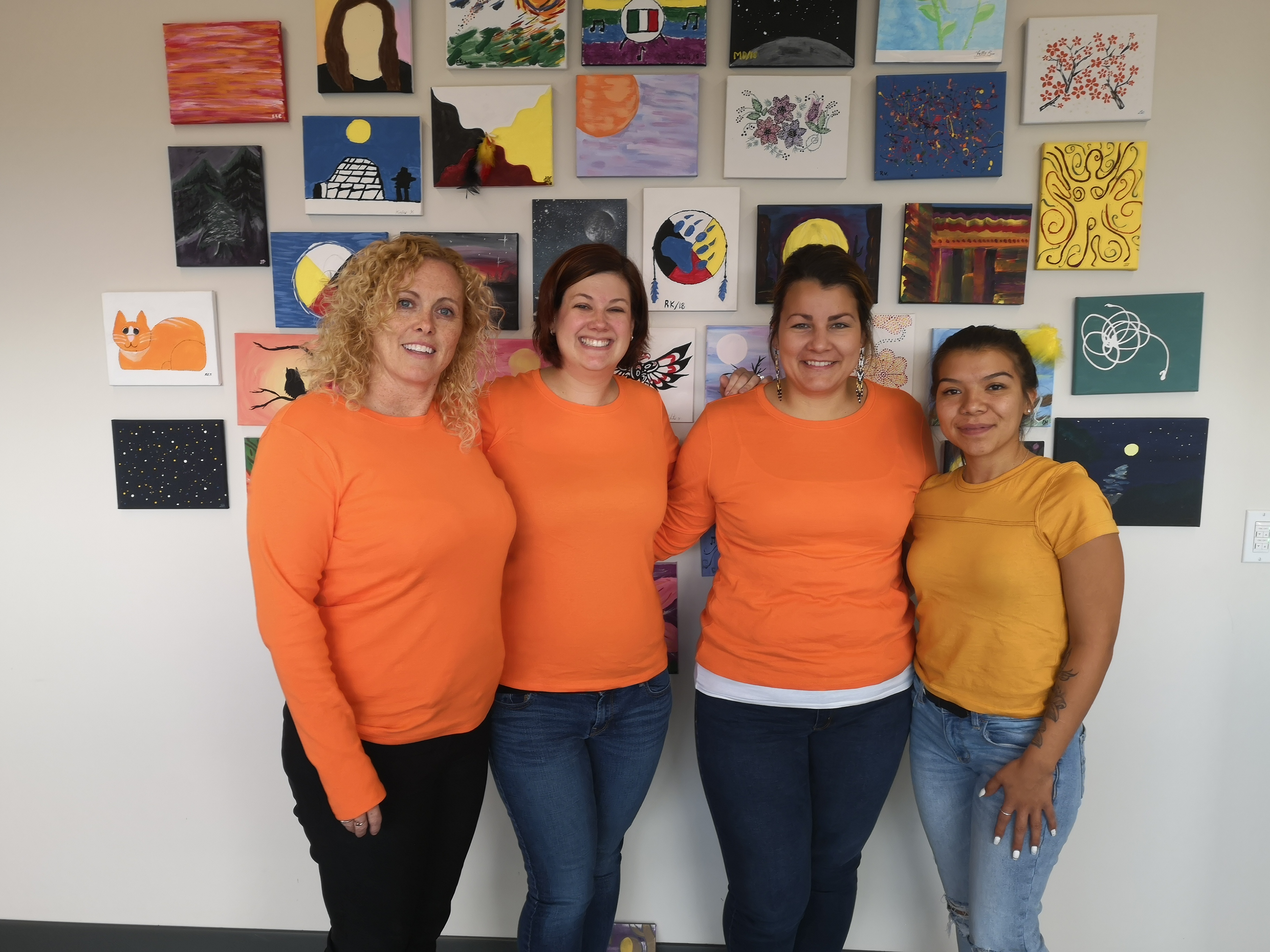
Orange Shirt Day. Observed annually on September 30, Orange Shirt Day "is an opportunity to create meaningful discussion about the effects of Residential Schools and the legacy they have left behind. A discussion all Canadians can tune into and create bridges with each other for reconciliation. A day for survivors to be reaffirmed that they matter, and so do those that have been affected. Every Child Matters, even if they are an adult, from now on." Learn more.
Why is it important to learn Indigenous history?
Holly: Our time to be heard is now. Our voices have been silenced for so long, Canada's colonial project of erasure was attempted and failed. But now there is a subtle shift in this landscape that is now called "Canada" and I believe if we all face the truth of our shared past with humility we can forge on and strive to be equals together. True history is not an "Indian problem" it is a Canadian solution, we are all Treaty people. I trust we can all embrace a shared historical consciousness.
Christina: So many reasons! Reconciliation cannot occur if those of us who are non-indigenous fail to understand or respect the impact of colonization on Indigenous culture. As residents in this country and on this shared land, it is important to reflect on my privilege. The land that I live and work on did not belong to my ancestors. Too many people fail to realize that many atrocities occurred in our recent past (within my lifetime), and by way of systemic racism continue in our present day. From an educational standpoint, this deeply impacts the students we serve and how we support their learning.
It's also about being a good global citizen. We become stronger together when we take the time to learn about other's lived experiences and culture. This naturally develops compassion and expands our world view. Plus, it's such a beautiful culture - the teachings are universal.
Sarah: It is important to learn about history to be a support and an ally. We cannot fully understand the depth of pain and trauma that was experienced and the sense of loss that is felt, but knowledge of history helps us try to understand what happen and why its so important to reconcile what our ancestors did in the past. And why we need to take an active role in this process to help honour, respect, and support Indigenous friends, students, and neighbors. This empathy and understanding can also create more positive relationships in the College and community as we continue to move forward.
Jody: "An examination of the past - and of the present, for that matter - can be instructive." -Thomas King
There are several reasons why it is important to learn Indigenous history (especially the facts), but to sum it up into one statement, I'd say that the information helps people to move forward and take the risks needed to fight their fears and other emotions so that people are not imprisoned by their past.

Healing blankets were created for the Sexual Assault Centre Kingston. The inner lining contains messages of hope, support and encouragement which we then tie together, symbolizing strength and community, and infuse with medicine for the healing journey ahead.
How are you sharing or promoting Indigenous Ways of Knowing and Being in the classroom?
Holly: Infusing Indigenous Ways of Knowing (knowledge) and Being in the classroom:
- Invite a Survivor of the residential school legacy into the classroom to tell their story.
- If possible, arrange your classroom in a circle and explain why you think this is a good way to learn.
- Invite an Indigenous guest speaker into the classroom to talk about their area of specialty (i.e., on the land activities or medicine or author) or a PhD/Masters Indigenous student to talk about their story. This becomes a way to demonstrate role models.
- Get students to watch a movie made by Indigenous people and ask students to reflect on what they have learned or saw. Does the lens from which we view the movie change? Whose narrative is it?
- Understand that there are more than one way to come to a conclusion.
- Rather than writing a paper for an assignment, have them tell a story, choreograph a dance, a play, and challenge the rest of the students to tell them the meaning of it.
- As an assignment, challenge students to tell them whose territory their house sits upon and tell the rest of the students something about that Nation.
- Learn about the concept of Two Eyed Seeing (see Albert Marshall).
- Have a talking circle at the end of any session and allow students to process what they have learned. Reflection is important. Ask their opinion! Make it safe and inclusive.
- At the very last class or the very first class have an Indigenous person come in and lead a social dance like the Round Dance, everyone is invited to come and dance and learn, it is the ethic of inclusion.
Christina: The VCA-FA program has done a couple of projects specific to Indigenous culture. Most recently, with the assistance of Shirley, we examined the 7 Grandfather teachings. Those really helped to open dialogue and exploration into both the teachings and Indigenous artists. These discussions allowed us to explore social injustices and their impact in a context relevant to the students. I hope to incorporate the 13 Grandmother Moons into curriculum in the future.
Often having Indigenous students in our program, I try to provide opportunity for them to share their culture either through their projects or in class discussion. We're all better artists and humans because of it.
Reflection is a big part of my lessons - finding ways to connect students to content in a way that is relevant to their personal culture. The expansion of one's world view is so important to their development as a PERSON, much less an artist. Discussing teachings has allowed students to reflect on what they mean to them and I think helped to re-shape some attitudes and beliefs.
I have recently written Indigenous learning into the program curriculum so regardless who teaches the content, they are required to include it as part of a student's experience.
Jordan: I am sharing and promoting Indigenous Ways of Knowing and Being (IWKB) in the classroom by acknowledging with students that I am actively learning about IWKB myself. When appropriate, I share information about the workshops I am attending, recent video clips or readings I have found informative, and incorporate discussion on current events and how they relate to what we are covering in class. Sharing what I am learning has led to wider conversations about what students want to explore to further their own understanding of IWKB, and as I become aware of more Indigenous resources, I can better support all students in their effort to do this.
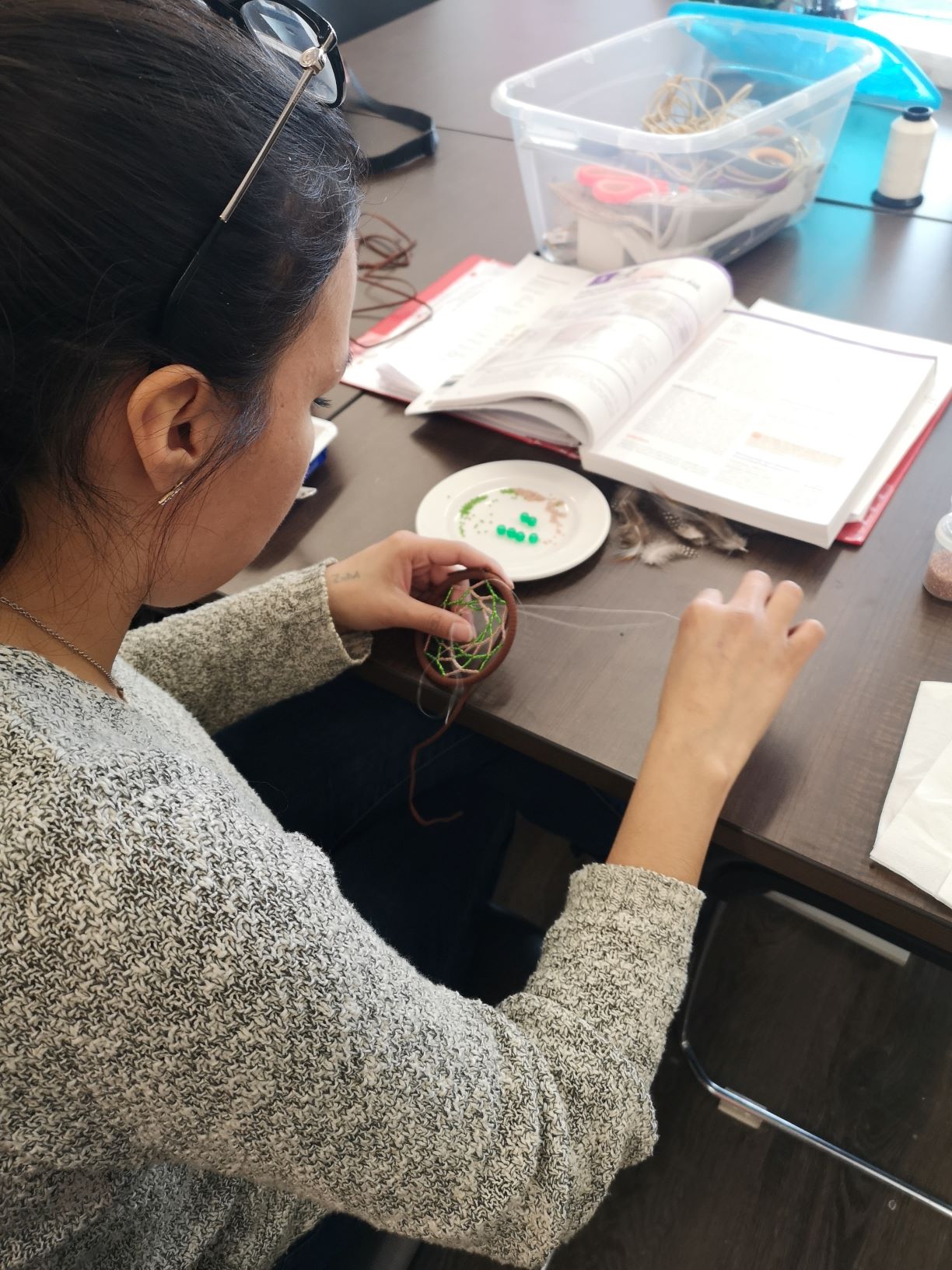
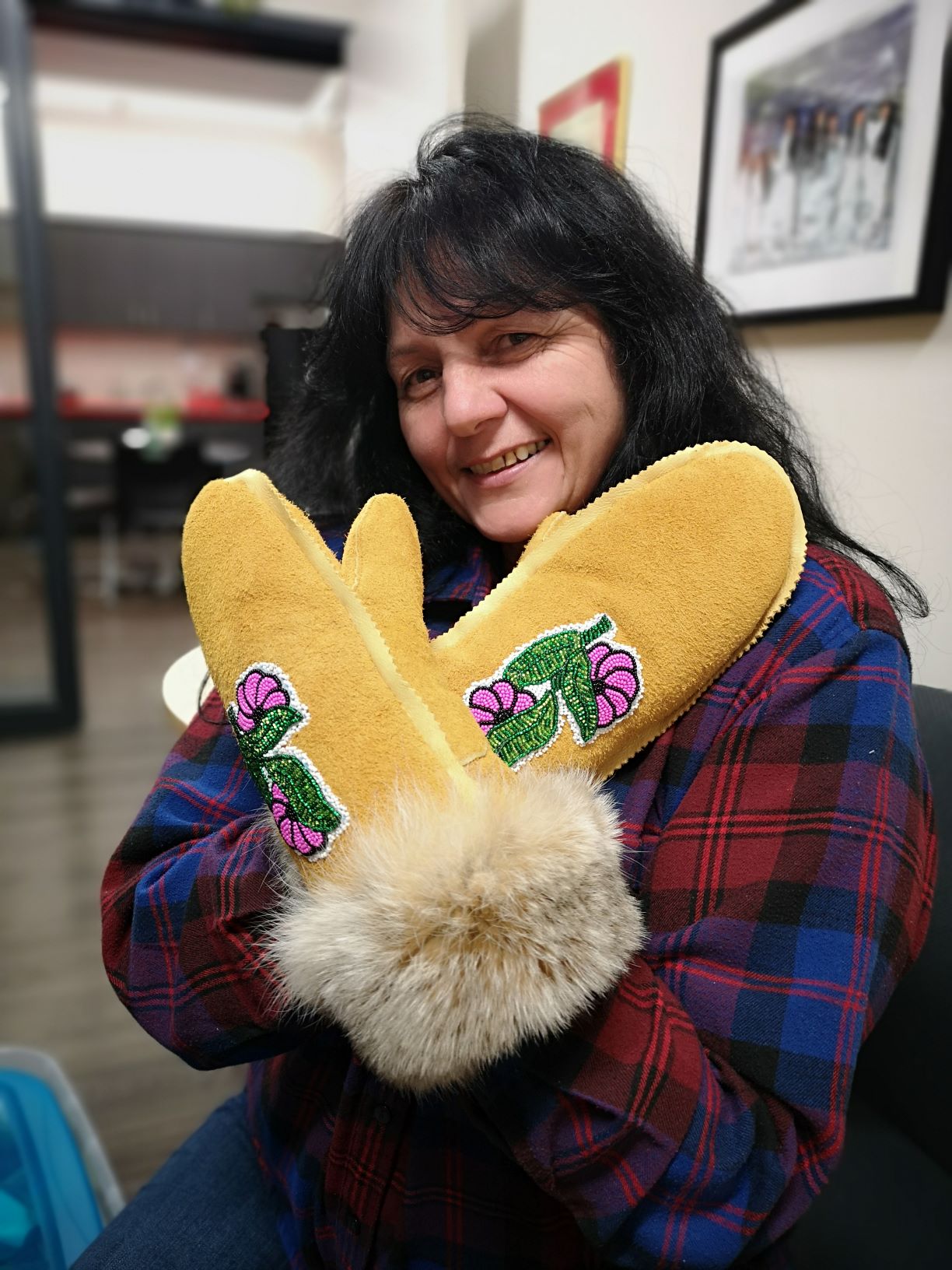
Left: Making dream catchers in the Indigenous Centre. Right: Elder Helena Neveu, proud Ojibway woman from the Batchewana First Nation in Northern Ontario, and a member of the crane clan.
What is the most valuable teaching or resource you have received on Indigenous Ways of Knowing and Being?
Holly: Appropriate versus Appropriation.
It is important to learn the history of Indigenous peoples, it is incumbent on all of us to know the history and teach it, even if it reveals Canada’s hidden secrets of violence, of Canada’s colonial history. We all must know the true history of Canada, both the good aspects but also the darker aspects. We must know where we have been so we may know where to go.
There is a difference between people who study and learn about Indigenous ways of knowing and being, they are the people who study it and there are the people who live it.
If you were exposed to something sacred, do not try to teach it (unless you have been given that explicit responsibility). There is a difference between ceremonial and social. In a social Indigenous dance for instance you may be asked to join in, and have fun. That is appropriate and fun. There are Indigenous games played for social fun, learn them, have fun. However, ceremony is considered sacred. Only when you have been given that responsibility by an Elder or Indigenous knowledge holder do you share that knowledge because there will be teachings that go along with that sacred ceremony and only those who already have that responsibility can pass that responsibility along. You may be invited into a ceremony that means that you are welcomed and have approval to participate.
Sarah: The most valuable experience personally was an opportunity to travel to Nunavut and be immersed in a culture that was different than my own, meet Inuit people and listen to their stories about their loss of culture and experience their celebration of what culture and teachings had survived. I also value the stories and teachings I get from working with the Indigenous students I have supported. Listening to their struggles and challenges and helping them connect with appropriate resources and learning from the experience.
Jennifer: The most valuable teaching that I have participated in was the KAIROS Blanket Exercise. The goal of this exercise is to build an understanding about the shared history between Indigenous and non-Indigenous peoples in Canada. The exercise walks the participants through pre-contact, treaty-making, colonization, and resistance. This is an incredibly powerful exercise that not only educates but also engages on an emotional level.
ed. note: We received many recommendations for books and other resources; we will compile them in a list and share in next week's issue of Our College News.
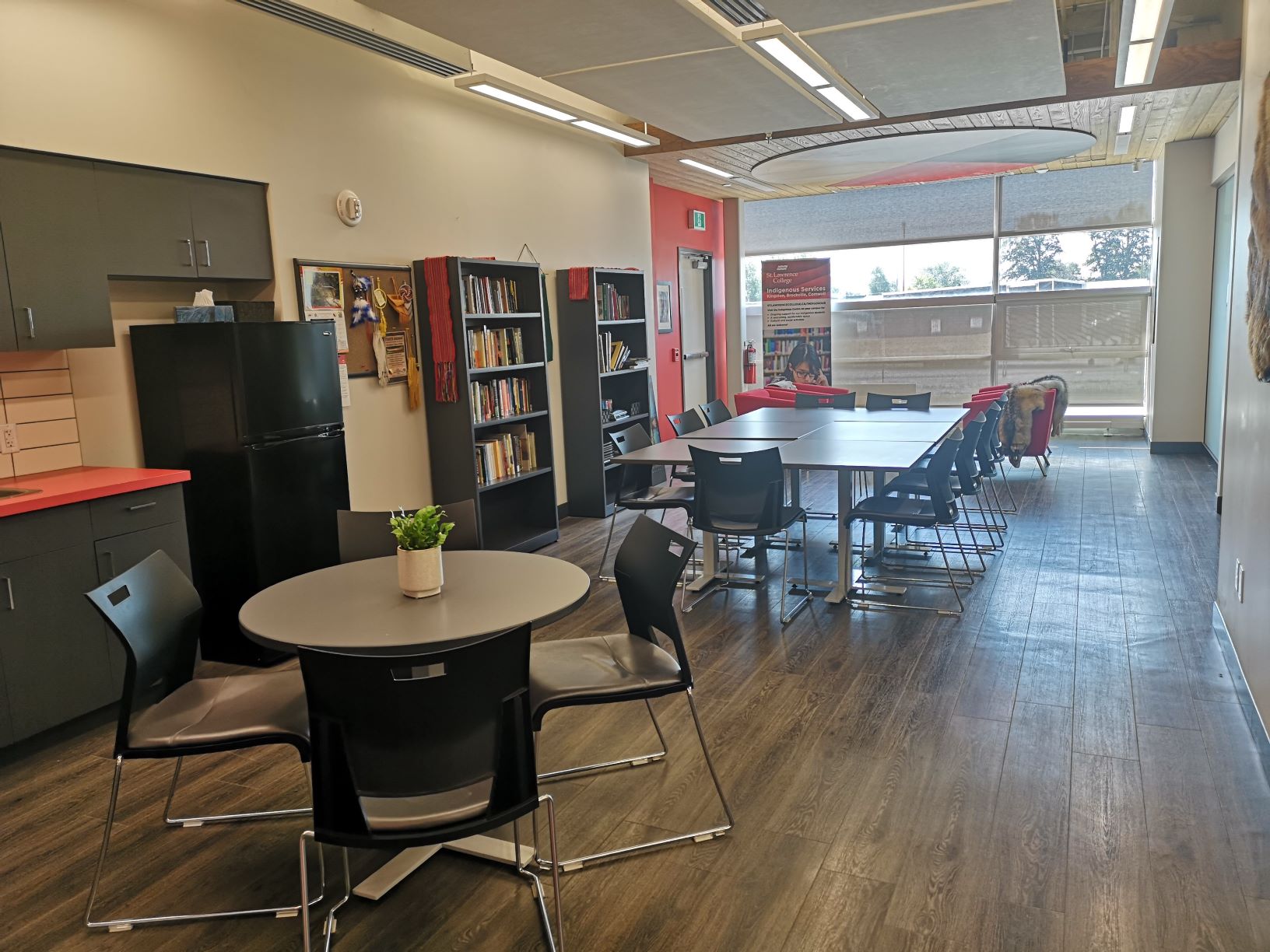
Each campus has an Indigenous Centre: a comfortable space for Indigenous students to relax, study, and interact with other Indigenous students. Pictured is the new Indigenous Centre in Kingston, which was completed in 2018 as part of the Hello Future Project's brand new Student Life and Innovation Centre.
